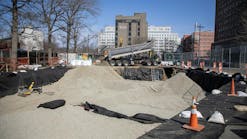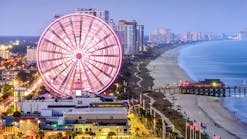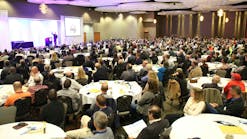Philly sports fans are notorious for their passion, enthusiasm and relentlessness. Snow, sleet or rain, fans pack the Eagles’ and Phillies’ stadiums to cheer on their teams, and tailgating is a big part of the fan culture.
As city and team officials sought to maximize the available space for parking and tailgating, they targeted an old warehouse near the teams’ neighboring stadiums.
Officials razed the building after years of sitting dilapidated to create the environment fans wanted, and simultaneously implemented plans to protect the city’s aging stormwater infrastructure.
With sustainability goals in mind, officials chose precast concrete to provide a long-term solution.
Green City, Clean Waters
Philadelphia holds prominence in American history textbooks for many reasons, but few know the city was also at the forefront of treating and supplying water. In 1801, it became the first American city to provide drinking water to its citizens. Its sewer system is one of the oldest in the country, and some of the original infrastructure is still operational today.
As the city grew and environmental requirements changed, it became evident that the aging combined sewers that serviced the city were no longer viable.
In 2011, the Philadelphia Water Department unveiled its Green City, Clean Waters plan – a 25-year commitment to manage runoff and inject more sustainable infrastructure projects into the city’s watersheds.
The city’s program is multi-faceted and ranges from preserving open space and planting trees to restoring streams and stormwater infrastructure. It features “Greened Acres” that filter or store the first inch of rainwater runoff every time it rains. The city is seeking to convert many vacant and abandoned lands to reduce the stress on its stormwater infrastructure.
Darien Crossing
RES, a water resource management firm specializing in ecological solutions, received a Green City, Clean Waters program grant to complete a stadium parking project known as Darien Crossing. The resulting parking lot features large green space areas that serve as a filtration system for rainwater that is then stored and slowly released into the city’s stormwater infrastructure.
Ed Linkewich, P.G., served as the project manager for RES. He said that as RES was designing the stormwater system, it became evident it would use precast concrete due to the site’s constraints, including unusual soil conditions.
“Our forefathers basically utilized historic fill like demolition debris and incinerator waste to fill whatever wetlands were near the Delaware River to build them up to a height so they could make buildings,” Linkewich said. “By utilizing precast structures, it gave us a large amount of structural stability that we wouldn’t have been able to gain by using a plastic product.”
While the soil presented a major challenge, it was far from the only one.
“We installed the foundation at negative 1 foot above sea level,” Linkewich explained. “Even after we put the foundation and precast units in, we were still about four feet below grade.”
This means there is nearly eight feet of soil on top of the stormwater system.
“These units had to withstand a large volume of weight on top of them while also holding a bunch of water,” Linkewich noted. “Weight really was the key factor in determining what material we needed to use.”
RES engaged StormTrap early to come up with a solution for the project, and the two worked hand-in-hand throughout the entire process.
Justin Nace, StormTrap’s Pennsylvania territory manager, said they worked through several design iterations with RES to get everything just right.
“This was a very specific, not a cookie-cutter type of project,” Nace explained. “We went through at least four or five conceptual options, fine-tuning things with the department and the project owner.”
Smooth sailing
A.C. Miller Concrete Products in Spring City, Pa., manufactured a total of 455 StormTrap units for the project. The company has been working with StormTrap for several years, and this project was one of the bigger ones they’ve done.
“Once we get above 250 pieces, we consider that a pretty large job,” said Owner and General Manager Dave Miller. “So this one was certainly on that scale.”
A.C. Miller was able to relocate some forms from its plant in Blairsville, Pa., to Spring City so it could produce more pieces at one time. It also started pouring on Saturdays to ensure deadlines were being hit.
Having done several StormTrap projects in the past, Miller was very familiar with what the project owners needed for the stormwater detention system.
“It’s pretty consistent, very modular, very adaptable,” Miller said. “It was a lot of pieces, but it went very smooth.”
A.C. Miller completed production in just a couple of months and shipped the pieces down to Philadelphia without delay. Linkewich paid a visit to the precaster during production and came away impressed with the process.
“They were putting the rebar and forms together, which was really cool to see,” he said. “They are very well built, and the tolerance was great in that it saved a lot of headaches on the back end.”
As soon as units arrived at the job site on a truck, they were unloaded and set into position.
“The precision was such that we were able to seal the entire system utilizing joint wrap,” Linkewich said. “They were formed so well, and the tolerances were extremely close. That made life very easy for us.
“It was surprising how fast we got those boxes installed, wrapped, sealed and buried – it was crazy it was just the course of months.”
Linkewich also touted the benefits of how easily the installation could be done with a smaller crew.
“You just need a couple guys and a truck driver,” he said. “As soon as these were getting in, another crew was coming.”
Teamwork from start to finish
With all precast pieces installed and work on converting the space to a parking lot underway, everyone raved about the collaboration from design to installation.
“It was a beautiful example of a number of different parties coming together for a common goal,” Nace said. “It was great to really partner with one another and work homogeneously together.”
Linkewich said he didn’t have much experience in using precast in the past, but plans to use more after this project based on how things went.
“We’re always looking to replicate work we’ve completed,” he said. “Working with StormTrap and the precaster, they allowed us to work unimpeded without any delays that held up our schedule so that was great.”
Philadelphia now has a place for fans to enjoy themselves while also furthering its sustainability goals with another Greened Acre.
“The site was unused for a long time and was a problem,” Linkewich said. “By doing this, we made a positive impact on the city, and we’re providing them a great value as they meet their future goals in sustainability.”
Matt Werner is the managing editor of Precast Solutions magazine and is NPCA’s communication manager.
Editor's Note: Scranton Gillette Communications and the SGC Water Group are not liable for the accuracy, efficacy and validity of the claims made in this piece. The views expressed in this content do not reflect the position of the editorial teams of Water & Wastes Digest, Water Quality Products and Storm Water Solutions.







